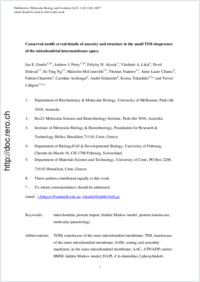Conserved motifs reveal details of ancestry and structure in the small tim chaperones of the mitochondrial intermembrane space
- Gentle, Ian E. Department of Biochemistry and Molecular Biology, University of Melbourne, Parkville, Australia - Bio21 Molecular Science and Biotechnology Institute, Parkville, Australia
- Perry, Andrew J. Department of Biochemistry and Molecular Biology, University of Melbourne, Parkville, Australia - Bio21 Molecular Science and Biotechnology Institute, Parkville, Australia
- Alcock, Felicity H. Institute of Molecular Biology and Biotechnology, Foundation for Research and Technology Hellas, Heraklion, Crete, Greece
- Likic, Vladimir A. Bio21 Molecular Science and Biotechnology Institute, Parkville, Australia
- Dolezal, Pavel Department of Biochemistry and Molecular Biology, University of Melbourne, Parkville, Australia - Bio21 Molecular Science and Biotechnology Institute, Parkville, Australia
- Ng, Ee Ting Department of Biochemistry and Molecular Biology, University of Melbourne, Parkville, Australia - Bio21 Molecular Science and Biotechnology Institute, Parkville, Australia
- Purcell, Anthony W. Department of Biochemistry and Molecular Biology, University of Melbourne, Parkville, Australia - Bio21 Molecular Science and Biotechnology Institute, Parkville, Australia
- McConnville, Malcolm Department of Biochemistry and Molecular Biology, University of Melbourne, Parkville, Australia - Bio21 Molecular Science and Biotechnology Institute, Parkville, Australia
- Naderer, Thomas Department of Biochemistry and Molecular Biology, University of Melbourne, Parkville, Australia - Bio21 Molecular Science and Biotechnology Institute, Parkville, Australia
- Chanez, Anne-Laure Department of Biology/Cell and Developmental Biology, University of Fribourg, Switzerland
- Charrière, Fabien Department of Biology/Cell and Developmental Biology, University of Fribourg, Switzerland
- Aschinger, Caroline Department of Biology/Cell and Developmental Biology, University of Fribourg, Switzerland
- Schneider, André Department of Biology/Cell and Developmental Biology, University of Fribourg, Switzerland
- Tokatlidis, Kostas Institute of Molecular Biology and Biotechnology, Foundation for Research and Technology Hellas, Heraklion, Crete, Greece - Department of Materials Science and Technology, University of Crete, Heraklion, Crete, Greece
- Lithgow, Trevor Department of Biochemistry and Molecular Biology, University of Melbourne, Parkville, Australia - Bio21 Molecular Science and Biotechnology Institute, Parkville, Australia
-
28.02.2007
Published in:
- Molecular Biology and Evolution. - 2007, vol. 24, no. 5, p. 1149-1160
English
The mitochondrial inner and outer membranes are composed of a variety of integral membrane proteins, assembled into the membranes posttranslationally. The small translocase of the inner mitochondrial membranes (TIMs) are a group of ∼10 kDa proteins that function as chaperones to ferry the imported proteins across the mitochondrial intermembrane space to the outer and inner membranes. In yeast, there are 5 small TIM proteins: Tim8, Tim9, Tim10, Tim12, and Tim13, with equivalent proteins reported in humans. Using hidden Markov models, we find that many eukaryotes have proteins equivalent to the Tim8 and Tim13 and the Tim9 and Tim10 subunits. Some eukaryotes provide "snapshots" of evolution, with a single protein showing the features of both Tim8 and Tim13, suggesting that a single progenitor gene has given rise to each of the small TIMs through duplication and modification. We show that no "Tim12" family of proteins exist, but rather that variant forms of the cognate small TIMs have been recently duplicated and modified to provide new functions: the yeast Tim12 is a modified form of Tim10, whereas in humans and some protists variant forms of Tim9, Tim8, and Tim13 are found instead. Sequence motif analysis reveals acidic residues conserved in the Tim10 substrate-binding tentacles, whereas more hydrophobic residues are found in the equivalent substrate-binding region of Tim13. The substrate-binding region of Tim10 and Tim13 represent structurally independent domains: when the acidic domain from Tim10 is attached to Tim13, the Tim8–Tim13¹⁰ complex becomes essential and the Tim9–Tim10 complex becomes dispensable. The conserved features in the Tim10 and Tim13 subunits provide distinct binding surfaces to accommodate the broad range of substrate proteins delivered to the mitochondrial inner and outer membranes.
- Faculty
- Faculté des sciences et de médecine
- Department
- Département de Biologie
- Language
-
- English
- Classification
- Biological sciences
- License
- License undefined
- Identifiers
-
- RERO DOC 8696
- DOI 10.1093/molbev/msm031
- Persistent URL
- https://folia.unifr.ch/unifr/documents/300537
Statistics
Document views: 76
File downloads:
- schneider_cmr.pdf: 131
